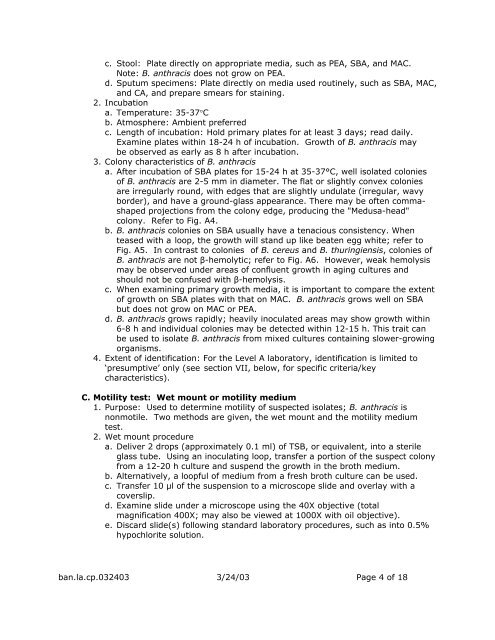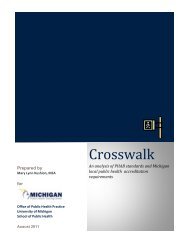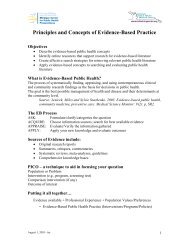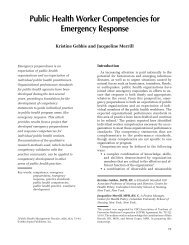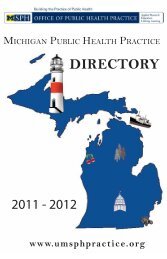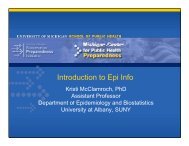Anthrax Lab Protocol - Office of Public Health Practice
Anthrax Lab Protocol - Office of Public Health Practice
Anthrax Lab Protocol - Office of Public Health Practice
Create successful ePaper yourself
Turn your PDF publications into a flip-book with our unique Google optimized e-Paper software.
c. Stool: Plate directly on appropriate media, such as PEA, SBA, and MAC.<br />
Note: B. anthracis does not grow on PEA.<br />
d. Sputum specimens: Plate directly on media used routinely, such as SBA, MAC,<br />
and CA, and prepare smears for staining.<br />
2. Incubation<br />
a. Temperature: 35-37°C<br />
b. Atmosphere: Ambient preferred<br />
c. Length <strong>of</strong> incubation: Hold primary plates for at least 3 days; read daily.<br />
Examine plates within 18-24 h <strong>of</strong> incubation. Growth <strong>of</strong> B. anthracis may<br />
be observed as early as 8 h after incubation.<br />
3. Colony characteristics <strong>of</strong> B. anthracis<br />
a. After incubation <strong>of</strong> SBA plates for 15-24 h at 35-37°C, well isolated colonies<br />
<strong>of</strong> B. anthracis are 2-5 mm in diameter. The flat or slightly convex colonies<br />
are irregularly round, with edges that are slightly undulate (irregular, wavy<br />
border), and have a ground-glass appearance. There may be <strong>of</strong>ten commashaped<br />
projections from the colony edge, producing the "Medusa-head"<br />
colony. Refer to Fig. A4.<br />
b. B. anthracis colonies on SBA usually have a tenacious consistency. When<br />
teased with a loop, the growth will stand up like beaten egg white; refer to<br />
Fig. A5. In contrast to colonies <strong>of</strong> B. cereus and B. thuringiensis, colonies <strong>of</strong><br />
B. anthracis are not β-hemolytic; refer to Fig. A6. However, weak hemolysis<br />
may be observed under areas <strong>of</strong> confluent growth in aging cultures and<br />
should not be confused with β-hemolysis.<br />
c. When examining primary growth media, it is important to compare the extent<br />
<strong>of</strong> growth on SBA plates with that on MAC. B. anthracis grows well on SBA<br />
but does not grow on MAC or PEA.<br />
d. B. anthracis grows rapidly; heavily inoculated areas may show growth within<br />
6-8 h and individual colonies may be detected within 12-15 h. This trait can<br />
be used to isolate B. anthracis from mixed cultures containing slower-growing<br />
organisms.<br />
4. Extent <strong>of</strong> identification: For the Level A laboratory, identification is limited to<br />
‘presumptive’ only (see section VII, below, for specific criteria/key<br />
characteristics).<br />
C. Motility test: Wet mount or motility medium<br />
1. Purpose: Used to determine motility <strong>of</strong> suspected isolates; B. anthracis is<br />
nonmotile. Two methods are given, the wet mount and the motility medium<br />
test.<br />
2. Wet mount procedure<br />
a. Deliver 2 drops (approximately 0.1 ml) <strong>of</strong> TSB, or equivalent, into a sterile<br />
glass tube. Using an inoculating loop, transfer a portion <strong>of</strong> the suspect colony<br />
from a 12-20 h culture and suspend the growth in the broth medium.<br />
b. Alternatively, a loopful <strong>of</strong> medium from a fresh broth culture can be used.<br />
c. Transfer 10 µl <strong>of</strong> the suspension to a microscope slide and overlay with a<br />
coverslip.<br />
d. Examine slide under a microscope using the 40X objective (total<br />
magnification 400X; may also be viewed at 1000X with oil objective).<br />
e. Discard slide(s) following standard laboratory procedures, such as into 0.5%<br />
hypochlorite solution.<br />
ban.la.cp.032403 3/24/03 Page 4 <strong>of</strong> 18


